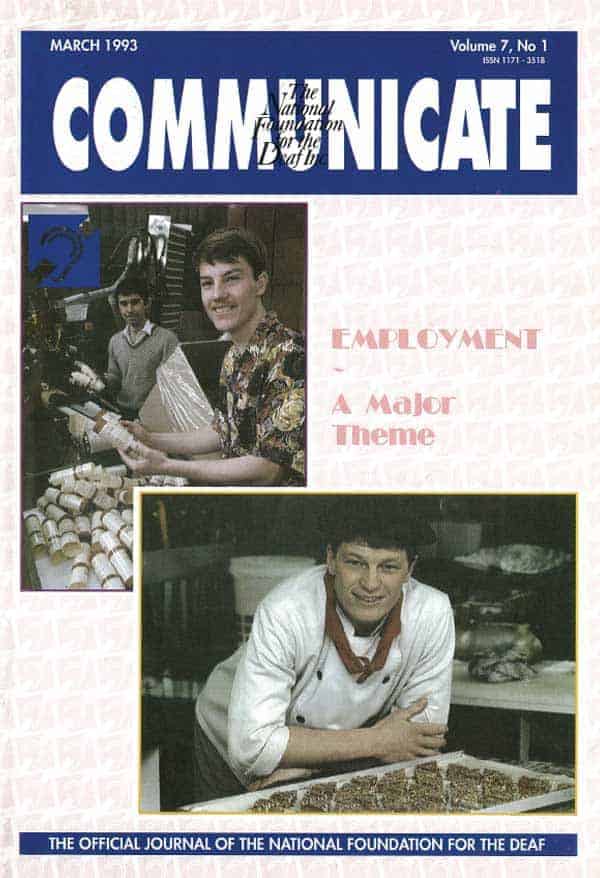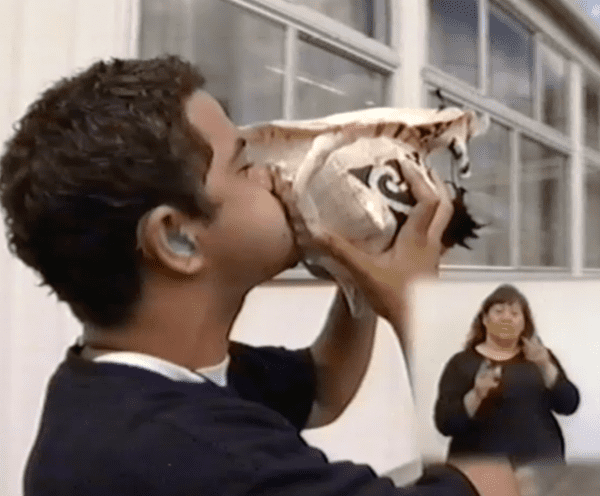Ko Rūaumoko – It is Rūaumoko, Koropupu – Who makes the geysers burst, Ana te wai – The water boil, Ruana te whenau e! – Who makes even the Earth tremble!
Rūaumoko Marae has been part of Deaf Māori community for 30 years and is a central part of Deaf Māori community. It’s a place where Deaf Māori can just be; they can connect and learn about te ao Māori.
- Deaf Education
- Turi Māori
Rūaumoko Marae takes its first breath

Opening of Rūaumoko Marae, 1992. Rachel McKee, Pat te Paa, Fonofili Va’alepu, John Wood, Darkie Graham.
Rūaumoko Marae was opened on the 4th December 1992 at Kelston Deaf Education Centre (KDEC) as a cultural learning environment for Deaf students to learn about Te Ao Māori or the Māori World. Since its opening it has become much more than that, in particular to the Māori Deaf community throughout New Zealand.
Naming the Marae

KDEC Marae for the Deaf, Western Leader, 7 December 1992. Article on the opening of Rūaumoko Marae. Carl Ross standing next to Tane Mahuta with pupils Rose Palu, Murray Speers and Reece Edge.
Rūaumoko means “unborn child” and the God of Earthquakes. The Marae was named Rūaumoko at least in part because the floor were used to gain attention by stamping, sending tremors through the floorboards.
Te Kaitiaki (caretaker) of the Marae Michael Wi explains “Rūaumoko makes the earth move and by doing so gets the attention of all creatures. This is a Deaf way too, Deaf people stamp on the floor to get attention because this sends vibrations through wooden boards”.
The sign for Rūaumoko is made by spreading both hands out and shaking them from left to right like an earthquake.
Learning at Rūaumoko

1997 Rūaumoko Entry Carvings. Ivan Tamepo explaining the meaning behind the carvings to Kelston students, Zachary Best, Dylan Louie, Ryan Cassidy and James Pole.
Rūaumoko plays a critical role in educating Deaf children from all over New Zealand about Māori culture and tikanga. The Marae has been supported by not only the KDEC board, but also by Māori Deaf leaders who are able to use Rūaumoko to engage with students.
Rebuilding the whare

1992 Rūaumoko Carving. Hilda Tamepo, Bill Katu, Bradley Poutai, Joseph Sua.
Rūaumoko Marae is fondly known as the “Heart of KDEC”. As Deaf awareness of Māori culture has grown and evolved so was the need to rebuild the whare “Rūaumoko” for the Deaf, Māori and Hearing communities of the future. The establishment of a new Māori centre of excellence was one of KDEC’s priorities for 2015/2016.
Knighted kaumatua (Te Arawa) Sir Toby Curtis, Kuia Dame June Mariu (Te Whanau a Apanui) and Rev Judy Cooper (Ngati Hine) graciously accepted to become patrons of the Rūaumoko rebuild.
International visitors

4 May 2009. The World Federation of the Deaf board in front of the Rūaumoko Marae (Source: Kelston Deaf Education Centre).

4 May 2009. The World Federation of the Deaf board given a Rūaumoko welcome (Source: Kelston Deaf Education Centre).
Rūaumoko Marae is the only Deaf marae of its kind in the world. Over the years Rūaumoko Marae has had many visitors from all around New Zealand including Ministers of Parliament and international guests including the Board of the World Federation of the Deaf.

















